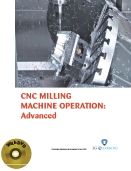Trade and Industrial Education

CNC Milling Machine Operation: Advanced comprehends various diverse practical and visual skills with knowledge of specialized materials and techniques. Milling is the machining process of using rotary cutters to remove material from a work piece advancing in a direction at an angle with the axis of the tool. Milling can be done with a wide range of machine tools. The original class of machine tools for milling was the milling machine (often called a mill). After the advent of computer numerical control (CNC), milling machines evolved into machining centers (milling machines with automatic tool changers, tool magazines or carousels, CNC control, coolant systems, and enclosures), generally classified as vertical machining centers (VMCs) and horizontal machining centers (HMCs). This book will introduce the knowledge and skills for those studying and/or working in CNC machining industry to interpret and convey information in response to workplace requirements.
About this Book
This book covers basic to core competencies that a person must achieve to write advanced CNC milling machine program, set-up multiple-axis CNC milling machine, work piece and cutting tools and perform advanced CNC milling machine operations.
About the CNC Machining Industry
A computer numerical control (CNC) machinist runs computer-operated equipment to create machine parts, tools and other mass-produced items. He or she may work in a machine shop or in the manufacturing industry as an expert in the installation, maintenance, programming and operation of CNC technology. CNC milling devices are the most widely used type of CNC machine. Typically, they are grouped by the number of axes on which they operate, which are labeled with various letters. X and Y designate horizontal movement of the work-piece (forward-and-back and side-to-side on a flat plane). Z represents vertical, or up-and-down, movement, while W represents diagonal movement across a vertical plane. Most machines offer from 3 to 5 axes, providing performance along at least the X, Y and Z axes. Advanced machines, such as 5-axis milling centers, require CAM programming for optimal performance due to the incredibly complex geometries involved in the machining process. These devices are extremely useful because they are able to produce shapes that would be nearly impossible using manual tooling methods. Most CNC milling machines also integrate a device for pumping cutting fluid to the cutting tool during machining. Entry-level operators load materials, such as blocks of titanium, steel, aluminum, or plastic, into CNC machines to be shaped. They calculate the amount of material to be fed into the machine, and make adjustments to the operating speed based on vibrations and sounds that may indicate a malfunction. Upon completion, an operator inspects the fabricated part to make sure that it matches specifications. Operators are responsible for cleaning and maintaining equipment, and often operate multiple machines. Experienced CNC set-up operators download control programs into individual machines and perform test operations to guarantee the machine properly creates the precise part. Set-up operators may work with a CNC programmer or modify the program directly before an entry-level operator takes over production. Individuals can learn skills through certificate or associate’s degree programs in machine or manufacturing technology. Relevant coursework covers blueprints, computer-aided design, machining principles, and metals. According to the U.S. Bureau of Labor Statistics, the median annual salary earned by computer-controlled machine tool operators for metals and plastic, including CNC lathe operators, was $35,900 as of May 2013.